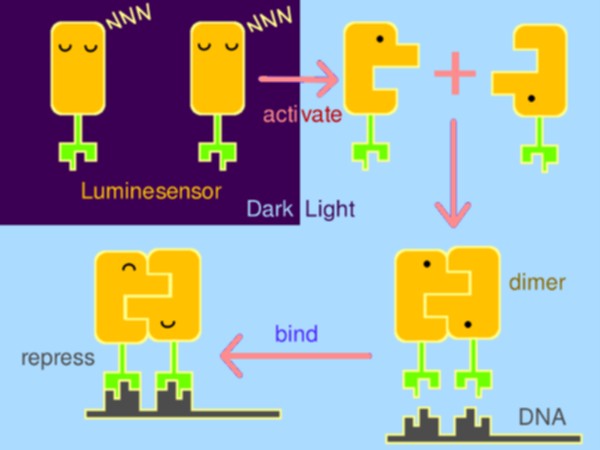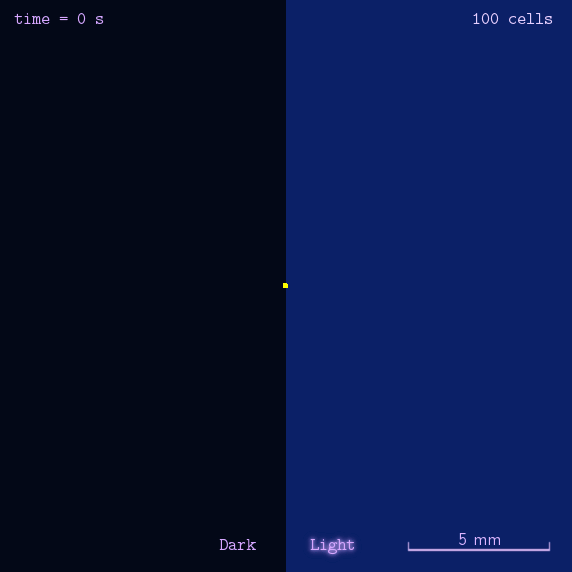Team:Peking
From 2012.igem.org
m |
|||
| Line 764: | Line 764: | ||
<div id="text-body"> | <div id="text-body"> | ||
<div class="floatC"> | <div class="floatC"> | ||
| - | <div class="floatL"><p class="title_block" style="font-size: | + | <div class="floatL"><p class="title_block" style="height:120px;font-size:36px;background-image:url('/wiki/images/b/be/Peking2012_Color_Title_AquaBlue.jpg');"><br /><br />Abstract</p></div> |
<div class="floatR"><p class="context_block" style="width:600px;"> | <div class="floatR"><p class="context_block" style="width:600px;"> | ||
Optogenetic tools have made significant impact on life sciences and beyond. However, several serious issues remain: cytotoxicy, narrow dynamic range, and dependency on laser and exogenous chromophore. To circumvent these, Peking iGEM has rationally constructed a hypersensitive sensor of luminance -- <b><i>Luminesensor</i></b>. Primarily, the sensor was designed by fusing blue-light-sensing protein domain from <i>Neurospora</i> with DNA binding domain of LexA from <i>E. coli</i>, following which protein structure inspection and kinetic simulation were conducted to rationally perform optimization. Amazingly, <i>Luminesensor</i> was proved to be as sensitive as to sense <b>natural light</b> and even <b>bioluminescence</b>. With this sensor, spatiotemporal control of cellular behavior, such as <b>high-resolution 2D</b> and <b>3D bio-printing</b> using dim light and even <b>luminescence of iPad</b> were shown to be very easy. What’s more, we successfully implemented <b>cell-cell signaling using light</b>, which is the very first time in synthetic biology and of great importance for biotechnological use. | Optogenetic tools have made significant impact on life sciences and beyond. However, several serious issues remain: cytotoxicy, narrow dynamic range, and dependency on laser and exogenous chromophore. To circumvent these, Peking iGEM has rationally constructed a hypersensitive sensor of luminance -- <b><i>Luminesensor</i></b>. Primarily, the sensor was designed by fusing blue-light-sensing protein domain from <i>Neurospora</i> with DNA binding domain of LexA from <i>E. coli</i>, following which protein structure inspection and kinetic simulation were conducted to rationally perform optimization. Amazingly, <i>Luminesensor</i> was proved to be as sensitive as to sense <b>natural light</b> and even <b>bioluminescence</b>. With this sensor, spatiotemporal control of cellular behavior, such as <b>high-resolution 2D</b> and <b>3D bio-printing</b> using dim light and even <b>luminescence of iPad</b> were shown to be very easy. What’s more, we successfully implemented <b>cell-cell signaling using light</b>, which is the very first time in synthetic biology and of great importance for biotechnological use. | ||
Revision as of 03:39, 20 September 2012
Abstract
Optogenetic tools have made significant impact on life sciences and beyond. However, several serious issues remain: cytotoxicy, narrow dynamic range, and dependency on laser and exogenous chromophore. To circumvent these, Peking iGEM has rationally constructed a hypersensitive sensor of luminance -- Luminesensor. Primarily, the sensor was designed by fusing blue-light-sensing protein domain from Neurospora with DNA binding domain of LexA from E. coli, following which protein structure inspection and kinetic simulation were conducted to rationally perform optimization. Amazingly, Luminesensor was proved to be as sensitive as to sense natural light and even bioluminescence. With this sensor, spatiotemporal control of cellular behavior, such as high-resolution 2D and 3D bio-printing using dim light and even luminescence of iPad were shown to be very easy. What’s more, we successfully implemented cell-cell signaling using light, which is the very first time in synthetic biology and of great importance for biotechnological use.
Luminesensor

With strong motivation to raise a new generation of optogenetics, Peking iGEM team has rationally constructed a hypersensitive sensor of luminance – what we call the Luminesensor, with which spatiotemporal control of biochemical process or cellular behavior is highly feasible. It provides a paradigm for rational design of sensor.
Light Communication

The ultrasensitive Luminesensor is able to respond to very dim light and still maintain a high dynamic range. That encouraged Peking iGEM to explore the possibility of cell-cell communication through light. We have successfully implemented that , for the very first time, light-communication among cells without direct physical contact.
Syn Bio in 2D & 3D

3D printing is a new technology that has been rising for many years. But in the realm of synthetic biology, it is far from developed. We exploited our Luminesensor to implement 3D printing that can be utilized in many applications in medical or manufacturing.
Phototaxis

"Phototatic" bacteria can be built by programming the chemotaxis system in E. coli through light. By controlling the expression level of the cheZ protein with Luminesensor, the tumbling frequency is coupled to the intensity of light signals.
 "
"










